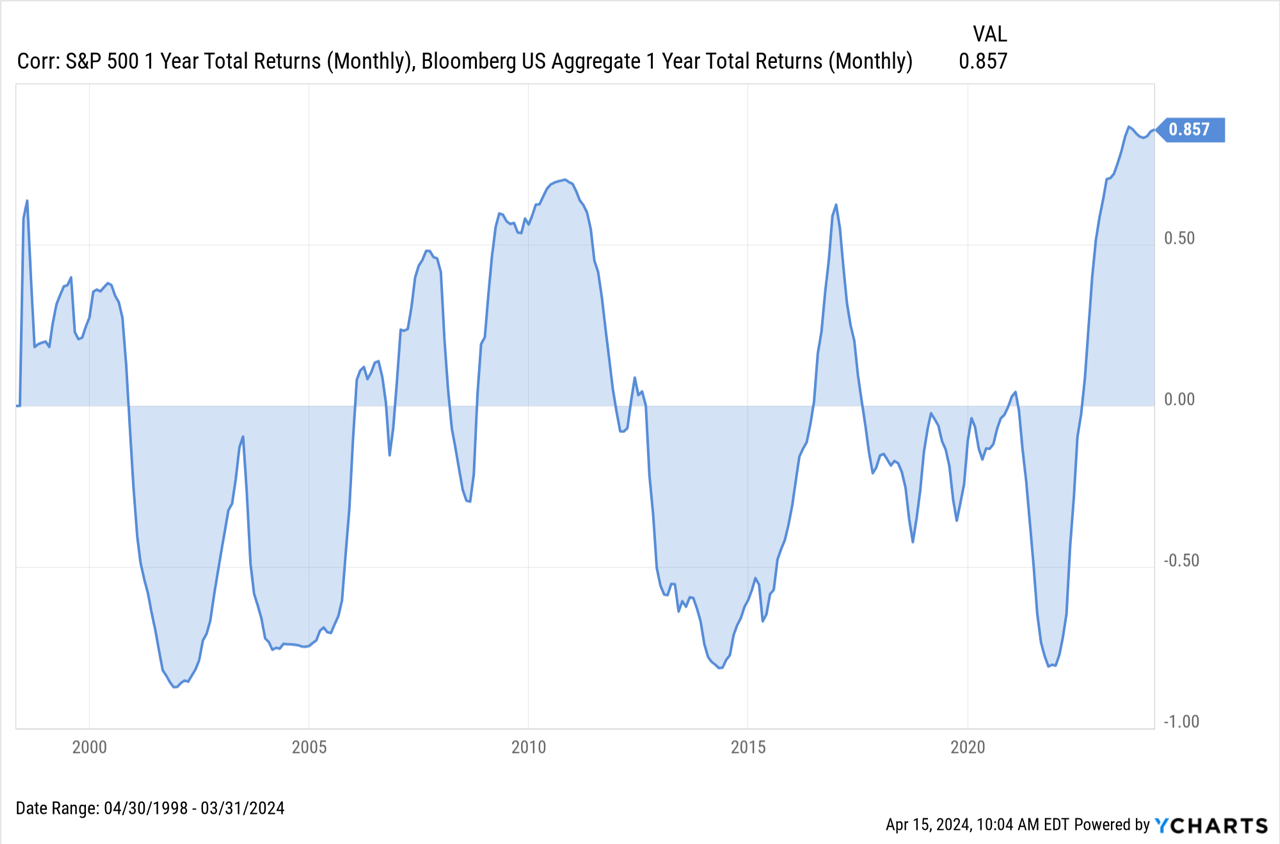The Evolving Relationship Between Stocks and Bonds Explained
Submitted by JMB Financial Managers on June 28th, 2024
Sir John Templeton once said, “The four most expensive words in investing are: ‘This time it’s different.'” Normally, we would agree. But the phrase “This time it’s different” may apply to what's happened in financial markets in recent years.

What’s New?
For most of the past quarter-century, the stock market and bond markets have moved in opposite directions. This inverse relationship created a negative correlation between these two asset classes. But in recent months, the correlation between stocks and bonds changed to a positive correlation. As you can see in the chart above (courtesy of YCharts), the correlation between the S&P 500 and the Bloomberg US Aggregate 1-year total return has been quite high lately. In other words, stocks and bonds are moving in the same direction, instead of the opposite direction. This phenomenon is starting to raise questions about the benefits of passive asset allocation.1
What’s the Cause?
The positive correlation began in 2022, but the most recent activity spotlighted the issue. As the Federal Reserve started raising interest rates in 2022 to manage inflation, bond prices (which generally move in the opposite direction of interest rates) trended lower. At the same time, economic concerns put pressure on stock prices, which fell into bear market territory for much of 2022.
The result: passive asset allocation did not produce the same past performance - and investors who used this strategy suffered severe losses. A traditional buy-and-hold, 60% stock/40% bond portfolio suffered its largest losses since the 2008 global financial crisis.2
What’s Next?
The answer to this question may depend on how the economy unfolds over the next few months, which is why the Fed is getting so much attention. Late last year, the Fed hinted that its next move could lead to lower interest rates, but it stopped short of giving a timeline.
Stocks and bonds trended together as Wall Street began to think the Fed may have pulled off a “soft landing,” where growth slows but the economy doesn’t tip into a recession. However, inflation risk is still elevated, so the Fed has been unwilling to change its policy, as it is waiting for consumer prices to stabilize.3
But what happens in the event of a hard landing? The ramifications could include job losses, credit tightening, higher yields, and market volatility. This may create a world where bonds and stocks might move in opposite directions and - voila - produce a negative correlation. But not too many people appear to be cheering for a hard landing.
A third possibility is "no landing," in which the Fed keeps rates at their current levels indefinitely because inflation remains high. It’s unclear how this would affect the correlation between stocks and bonds, however, a similar situation occurred in the high inflation period of the 1970's resulting in a high correlation between stocks and bonds.4
Our Perspective
There is a school of thought that the recent positive correlation between stocks and bonds is a return to historical norms rather than an anomaly.
One longer-term study showed that the past three decades of negative correlation where stocks and bonds moved in different directions should not trump three centuries of data showing that these asset classes moved more in sync.1
The study concluded that although the past two years have been rough, asset allocation should not be completely discarded as an investment concept. However, it did suggest that the economy appears to have moved past a long period of low inflation, which allowed the Fed to keep interest rates at low levels.
Helping Investors
The traditional approach to asset allocation has relied on the negative correlation between bonds and stocks to help smooth out the investment journey. Today’s positive correlation may have the opposite effect.
When we create an investment strategy, we base it on an investor’s financial goals, time horizon, and risk tolerance. We combine cyclical, fundamental, and technical analysis to stay abreast of the markets. Changes to any of these factors identify the need for adjustments and to bring new insights to clients as the climate changes.
If you are tired of an investment strategy that never evolves or adapts to changes in the markets, and would like to hear about a fresh perspective instead of the same old tired story, schedule a time to speak with us.
Perhaps you’re interested in a fresh perspective but want to learn more first. In the case, why don’t you begin by learning your Risk Score and what it can teach you about your portfolio.
1. MFS, October 2024. Stocks are represented by the S&P 500 Composite Index is an unmanaged index that is considered representative of the overall U.S. stock market. Index performance is not indicative of the past performance of a particular investment. Past performance does not guarantee future results. Individuals cannot invest directly in an index. The return and principal value of stock prices will fluctuate as market conditions change. And shares, when sold, may be worth more or less than their original cost.
Bonds are represented by the Bloomberg US Aggregate Bond Index. If you sell a bond prior to maturity, it may be worth more or less than the original price paid.
2. Morningstar, October 2023
https://www.morningstar.com/portfolios/is-6040-portfolio-good-investment-now
3. Reuters, January 2024
4. Vanguard.com, January 2024
--
About the Author
 Jack Brkich III, is the president and founder of JMB Financial Managers. A CERTIFIED FINANCIAL PLANNER TM, Jack is a trusted advisor and resource for business owners, individuals, and families. His advice about wealth creation and preservation techniques have appeared in publications including The Los Angeles Times, NASDAQ, Investopedia, and The Wall Street Journal. To learn more visit https://www.jmbfinmgrs.com/.
Jack Brkich III, is the president and founder of JMB Financial Managers. A CERTIFIED FINANCIAL PLANNER TM, Jack is a trusted advisor and resource for business owners, individuals, and families. His advice about wealth creation and preservation techniques have appeared in publications including The Los Angeles Times, NASDAQ, Investopedia, and The Wall Street Journal. To learn more visit https://www.jmbfinmgrs.com/.
Connect with Jack on LinkedIn or follow him on Twitter.
JMB Financial Managers Mid-Year Review for 2025
Click the button below to download a pdf of insights and predictions for the rest of the year.


